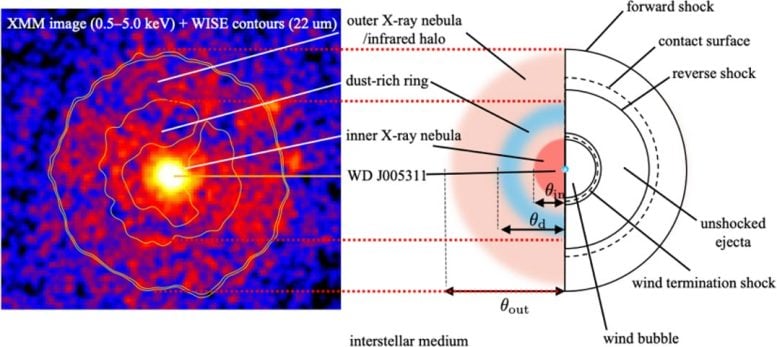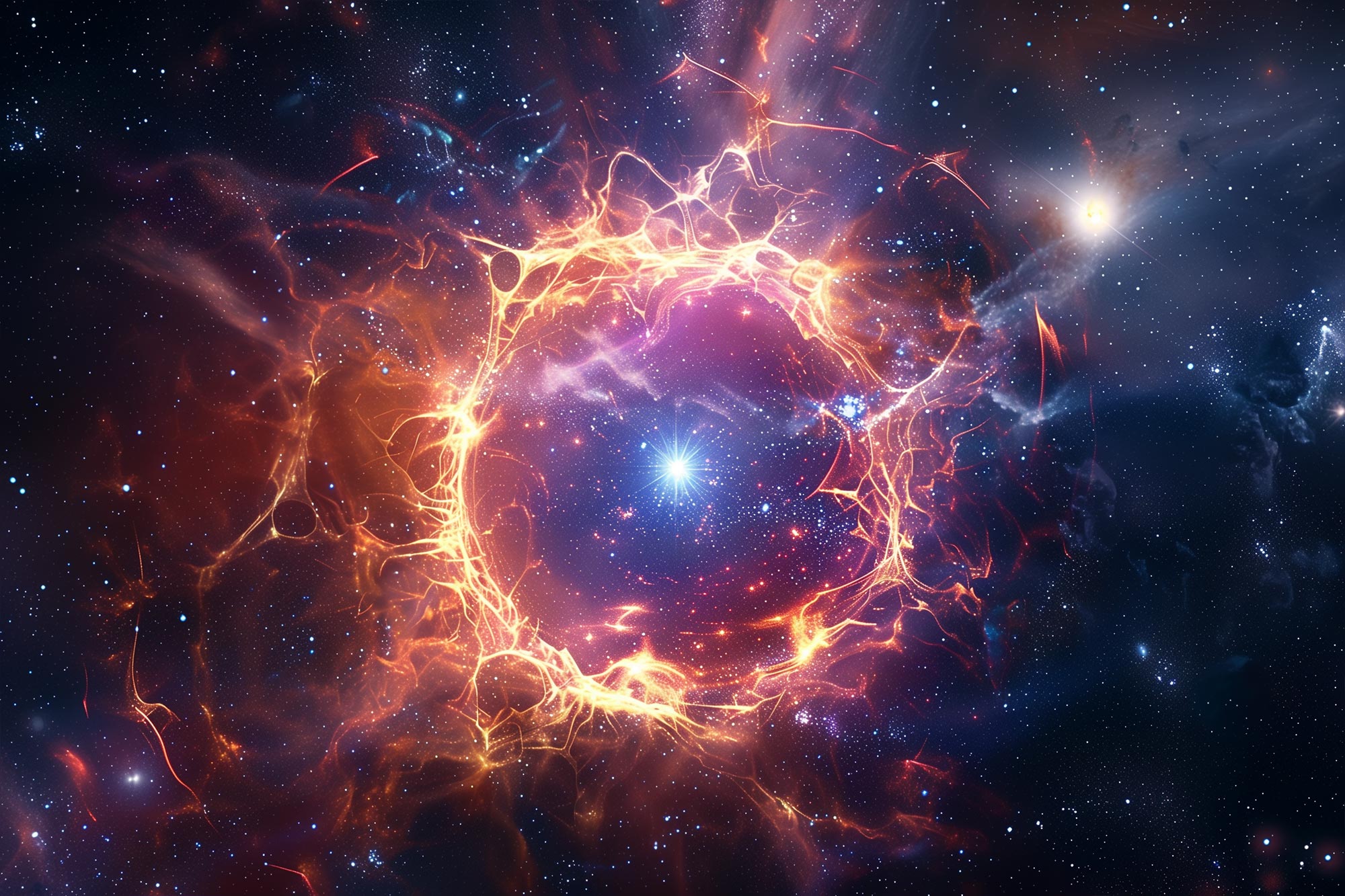Supernova 1181, resulting from the dramatic collision of two white dwarfs, has been studied through a blend of historical documentation and cutting-edge astronomy. The remnants, now identified in the Cassiopeia constellation, reveal a complex structure with signs of recent reignition, offering a unique perspective on the behavior of supernova remnants and their potential to reactivate. (Artist’s concept.) Credit: SciTechDaily.com
Elusive temporary star described in historical documents recreated using new computer model, shows it may have recently started generating stellar winds.
A supernova remnant from 1181, resulting from two colliding white dwarfs, was analyzed using historical records and modern astronomy. The discovery in the constellation Cassiopeia reveals a complex structure with new stellar winds, possibly indicating a reignition of the remnant star. This interdisciplinary approach provides deeper insights into the dynamics of stellar phenomena.
Artist’s impression of two 
These images show the two shock regions of the remnant SNR 1181. The bright white at the center is the white dwarf. Credit: 2024 T. Ko, H. Suzuki, K. Kashiyama et al./ The Astrophysical Journal
Historical Context and Observations
It is the year 1181 and in Japan the Genpei War (1180-1185) has recently begun. It will lead to a shift in political power from aristocratic families to the new military-based shogunate, which will establish itself in the coastal city of Kamakura near modern-day Tokyo. A record of this tumultuous period was compiled in a diary format in the Azuma Kagami. It chronicled not only people’s lives and key events (with varying 
This illustration charts the evolution of the SNR 1181 remnant, from its creation when a carbon-oxygen-based white dwarf and oxygen-neon white dwarf merged, to the formation of its two shock regions. Credit: 2024 T. Ko
Discovery and Analysis of SNR 1181
The remnant of this guest star, labeled supernova remnant (SNR) 1181, was found to have been created when two extremely dense, Earth-sized stars, called white dwarfs, collided. This created a rare type of supernova, called a Type Iax supernova, which left behind a single, bright and fast-rotating white dwarf. Aided by observations on its position noted in the historical document, modern astrophysicists finally pinpointed its location in 2021 in a nebula towards the constellation Cassiopeia.
Due to its rare nature and location within our galaxy, SNR 1181 has been the subject of much observational research. This suggested that SNR 1181 is made up of two shock regions, an outer region and an inner one. In this new study, the research group analyzed the latest X-ray data to construct a theoretical computer model to explain these observations, and which has recreated the previously unexplained structure of this supernova remnant.
Challenges in Understanding Supernova Properties
The main challenge was that according to conventional understanding, when two white dwarfs collide like this, they should explode and disappear. However, this merger left behind a white dwarf. The spinning white dwarf was expected to create a stellar wind (a fast-flowing stream of particles) immediately after its formation. However, what the researchers found was something else.
“If the wind had started blowing immediately after SNR 1181’s formation, we couldn’t reproduce the observed size of the inner shock region,” said Ko. “However, by treating the wind’s onset time as variable, we succeeded in explaining all of the observed features of SNR 1181 accurately and unraveling the mysterious properties of this high-speed wind. We were also able to simultaneously track the time evolution of each shock region, using numerical calculations.”
Future Research and Interdisciplinary Contributions
The team was very surprised to find that according to their calculations, the wind may have started blowing only very recently, within the past 20-30 years. They suggest this may indicate that the white dwarf has started to burn again, possibly due to some of the matter thrown out by the explosion witnessed in 1181 falling back to its surface, increasing its density and temperature over a threshold to restart burning.
To validate their computer model, the team is now preparing to further observe SNR 1181 using the Very Large Array (VLA) radio telescope based in central New Mexico state in the U.S., and the 8.2 meter-class Subaru Telescope in the U.S. state of Hawaii.
“The ability to determine the age of supernova remnants or the brightness at the time of their explosion through archaeological perspectives is a rare and invaluable asset to modern astronomy,” said Ko. “Such interdisciplinary research is both exciting and highlights the immense potential for combining diverse fields to uncover new dimensions of astronomical phenomena.”
Reference: “A Dynamical Model for IRAS 00500+6713: The Remnant of a Type Iax Supernova SN 1181 Hosting a Double Degenerate Merger Product WD J005311” by Takatoshi Ko, Hiromasa Suzuki, Kazumi Kashiyama, Hiroyuki Uchida, Takaaki Tanaka, Daichi Tsuna, Kotaro Fujisawa, Aya Bamba and Toshikazu Shigeyama, 5 July 2024, The DOI: 10.3847/1538-4357/ad4d99
Funding: This research has made use of data and software provided by the High Energy Astrophysics Science Archive Research Center (HEASARC), which is a service of the Astrophysics Science Division at





















Discussion about this post